Critically Endangered Animal Species
The Ministry of Environment and Forests in collaboration with the Zoological Survey of India, has released a Comprehensive Document on Critically Endangered Animal Species of India. The current extinction crisis has placed many species in the “Critically Endangered” category. It is the highest risk category assigned by the International Union for Conservation of Nature (IUCN) Red List, where all available evidence indicates an extremely high risk of extinction in the wild. The IUCN framework provides an objective evaluation that can be applied consistently by scientists and facilitates comparison across widely different groups of animals. The Critically Endangered Animal Species of Kerala, the data extracted from the above mentioned site is given below.
BIRDS
Spoon Billed Sandpiper
The Spoon Billed Sandpiper (Eurynorhynchus pygmeus) requires highly specialized breeding habitat, a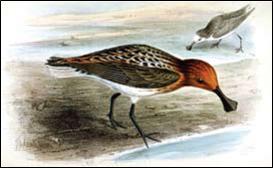 constraint that has always kept its population scarce. India is home to some of the last existing wintering grounds of this species (estimated at only 150-320 breeding pairs worldwide).
constraint that has always kept its population scarce. India is home to some of the last existing wintering grounds of this species (estimated at only 150-320 breeding pairs worldwide).
Habitat: Coastal areas with sparse vegetation. No breeding records further inland than 7 km from the seashore.
Distribution: Has been recorded in West Bengal, Orissa, Kerala and Tamil Nadu.
Threats: Habitat degradation and land reclamation. Human disturbance also leads to high incidence of nest desertion.
MAMMALS
Malabar Civet
The Malabar Civet (Viverra civettina) is considered to be one of the world’s rarest mammals. It is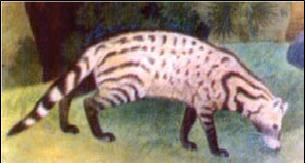 endemic to India and was first reported from Travancore, Kerala. It is nocturnal in nature and found exclusively in the Western Ghats.
endemic to India and was first reported from Travancore, Kerala. It is nocturnal in nature and found exclusively in the Western Ghats.
Habitat: Wooded plains and hill slopes of evergreen rainforests.
Distribution: Western Ghats.
Threats: Deforestation and commercial plantations are major threats.
REPTILES
Sispara day gecko
Sispara day gecko (Cnemaspis sisparensis) is a large gecko which dwells usually in forests; it is largely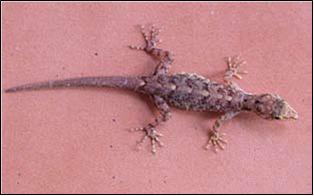 insectivorous and is active by night.
insectivorous and is active by night.
Distribution: Endemic to Western Ghats, and found in Sispara, Nilgiris, Kavalai near Cochin.
Threats: Habitat conversion and modification.
AMPHIBIANS
Anamalai Flying Frog
The Anamalai Flying Frog (Rhacophorus pseudomalabaricus) is confined to rainforests 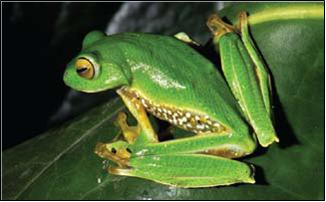 of southwestern Ghats and lives at elevations greater than 1,000 m above mean sea level.
of southwestern Ghats and lives at elevations greater than 1,000 m above mean sea level.
Distribution: It is found in Andiparai Shola, Pudothottam and the Anamalai Hills of Tamil Nada and Kerala.
Threats: Conversion of forest to cultivated land (including timber and non-timber plantations) outside the Indira Gandhi National Park, and extraction of wood and timber by local people are the major threats to this species.
Gundia Indian Frog
The Gundia Indian Frog (Indirana gundia) is found at an elevation of around 200 m above mean sea level.
level.
Distribution: Known only to exist in Gundia, Kempholey in the Western Ghats region of Karnataka, South India.
Threats: Habitat loss caused due to intensive livestock production, harvesting of wood and timber by local people, road construction, and the development of tourism facilities.
Kerala Indian Frog
The Kerala Indian Frog (Indirana phrynoderma) is found at elevations of around 500 m above 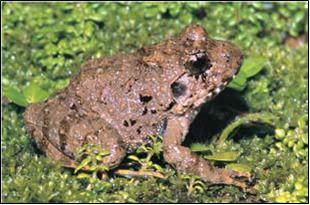 mean sea level. Due to the presence of prominent warts and tubercles of various sizes and glandular folds on its dorsal surface, it is commonly also known as the toad-skinned frog.
mean sea level. Due to the presence of prominent warts and tubercles of various sizes and glandular folds on its dorsal surface, it is commonly also known as the toad-skinned frog.
Distribution: Anamalai Hills of Kerala and Tamil Nadu in the Western Ghats of south India.
Threats: Habitat loss due to subsistence wood collection is the major threat to this species.
Chalazodes Bubble-Nest Frog
The Chalazodes Bubble-Nest Frog (Raorchestes chalazodes) was described in 1876 based on a s ingle female specimen, from “Travancore”, south India. There was no authentic report of this species since 1876 until its rediscovery in Febuary 2011.
ingle female specimen, from “Travancore”, south India. There was no authentic report of this species since 1876 until its rediscovery in Febuary 2011.
Distribution: All recorded specimens have been from the Western Ghats, India.
Threats: Conversion of forest to intensively cultivated areas.
Small Bush Frog
The Small Bush Frog (Raorchestes chotta) is the smallest bush frog found in Ind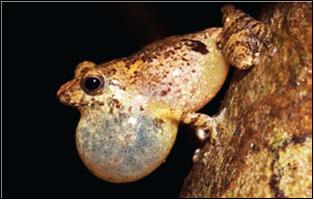 ia with a snout to vent length of 1.7 cm only. It was recently discovered in 2009 in
ia with a snout to vent length of 1.7 cm only. It was recently discovered in 2009 in
Ponmudi, Kerala in the Western Ghats. It is found at elevation of 980 m above mean sea level.
Distribution: Known only to occur in Ponmudi in Thiruvananthapuram district of Kerala, south India.
Threats: Extensive tea and Acacia plantations threaten the habitat of this species. While the species has been found to occur in abandoned plantations, its decline suggests that this species may not be tolerant to habitat changes or other unknown and less obvious threats.
Green-eyed Bush Frog
The Green-eyed Bush Frog (Raorchestes chlorosomma) was discovered in 2009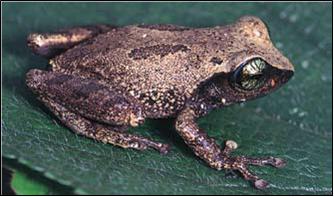 from Munnar in Idukki district of Kerala. This species has greyish green iris with irregular brown lines, bordered by a blue ring.
from Munnar in Idukki district of Kerala. This species has greyish green iris with irregular brown lines, bordered by a blue ring.
Distribution: Known only to occur in the type locality of Munnar, Idukki district, Kerala in the Western Ghats of South India.
Threats: Extensive degradation of habitat by large-scale tea, eucalyptus and wattle plantations. The expanding tourism industry is also becoming a cause of concern. Though the species seems to be adaptable, its tolerance to degraded habitats is not precisely known.
Griet Bush Frog
The Griet Bush Frog (Raorchestes griet) is a small frog of snout to vent length ranging from 2-2.2 cm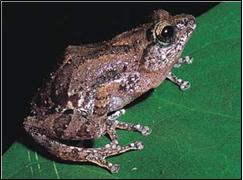 only. This species occurs at elevations between 600–1, 800 m above mean sea level.
only. This species occurs at elevations between 600–1, 800 m above mean sea level.
Distribution: Munnar, Devikulam and Vagaman in Idukki district of Kerala; and Anamalai Hills and Valparai in Coimbatore district of Tamil Nadu.
Threats: Habitat fragmentation due to tea and eucalyptus plantations. It is not likely to survive in the face of extensive habitat loss.
Kaikatt’s Bush Frog
The Kaikatt’s Bush Frog (Raorchestes kaikatti) was discovered in 2009 from Kaikatti-Nelliyampat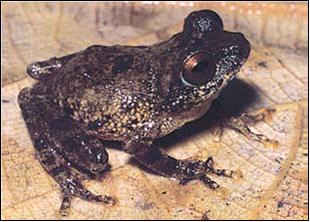 hi, in the Western Ghats of Kerala. This species occurs at an altitude of 1000 m above mean sea level.
hi, in the Western Ghats of Kerala. This species occurs at an altitude of 1000 m above mean sea level.
Distribution: Known only to occur in the type locality Kaikatti-Nelliyampathi in Palakkad district of Kerala, south India. It is believed to be endemic to the Nelliyampathi Hills.
Threats: Habitat loss and fragmentation due to small and large-scale agricultural practices and infrastructure development for tourism over the past five years.
Mark’s Bush Frog
The Mark’s Bush Frog (Raorchestes marki) was discovered in 2009 from Kaikatti-Nelliyampathi, in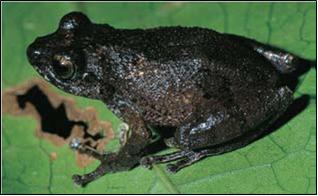 the Western Ghats of Kerala. This species is found at an altitude of 1000 m above mean sea level. Mark’s Bush frog is a small frog with snout to vent length ranging between 2.1-3 cm only.
the Western Ghats of Kerala. This species is found at an altitude of 1000 m above mean sea level. Mark’s Bush frog is a small frog with snout to vent length ranging between 2.1-3 cm only.
Distribution: Currently known to occur only in Kaikatti-Nelliyampathi in Palakkad district, Kerala, India.
Threats: Habitat loss and fragmentation due to small and large-scale agricultural practices, infrastructure development and construction for tourism over the last five years. However, adaptability of this species to disturbed environments is not known.
Munnar Bush Frog
The Munnar Bush Frog (Raorchestes munnarensis) was discovered in 2009 from Munnar in Idukk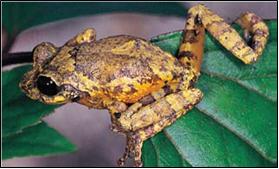 i district of Kerala. It is found at an elevation of about 1,400 m above mean sea level.
i district of Kerala. It is found at an elevation of about 1,400 m above mean sea level.
Distribution: Currently known only to occur in two locations, Devikulam and Munnar, Idukki district, Kerala, south India.
Threats: Habitat clearance for tea and eucalyptus plantations. This threat is very serious as there are no other known areas in the surrounding region that could be considered as suitable habitat for the species.
Large Ponmudi Bush Frog
The Large Ponmudi Bush Frog (Raorchestes ponmudi) is the largest bush frog of India with a snout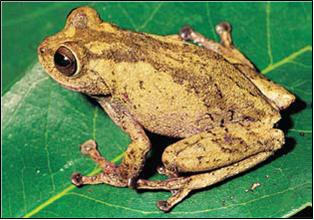 to vent length upto 4 cm.
to vent length upto 4 cm.
Distribution: Ponmudi and Agasthyamala Hills, Thiruvananthapuram district, Gavi, Pathanamthitta district, Vagaman, Idukki district., Wayanad Plateau, Kalpetta, Mananthavady and Sultan’s Battery, Wayanad district of Kerala; Anamalai Hills and Valparai, Coimbatore district, Tamil Nadu.
Threats: Habitat decline and the rate of forest loss is likely to further intensify due to the expansion of surrounding tea plantations.
Resplendent Shrub Frog
The Resplendent Shrub Frog (Raorchestes resplendens) was described in 2010 to occur in 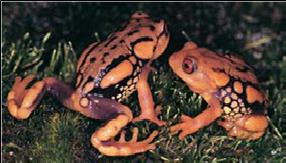 Anamudi Summit, Eravikulam National Park in the Western Ghats. The Resplendent Shrub Frog is a unique bush frog having brick red dorsal skin with black irregular furrows and prominent glands. This is the highest elevation bush frog reported from the Western Ghats from an altitude of 2,695 m above mean sea level.
Anamudi Summit, Eravikulam National Park in the Western Ghats. The Resplendent Shrub Frog is a unique bush frog having brick red dorsal skin with black irregular furrows and prominent glands. This is the highest elevation bush frog reported from the Western Ghats from an altitude of 2,695 m above mean sea level.
Distribution: Currently known to occur in Anamudi Summit, Eravikulam National park in the Idukki district, Kerala.
Threats: Occurs in a highly protected national park with secure habitat. Cause for observed declines remains unknown in view of its protected habitat.
Source: Zoological Survey of India, http://moef.nic.in/
A Comprehensive Document on Critically Endangered Animal Species of India- March 2011